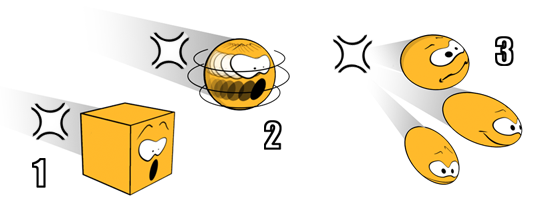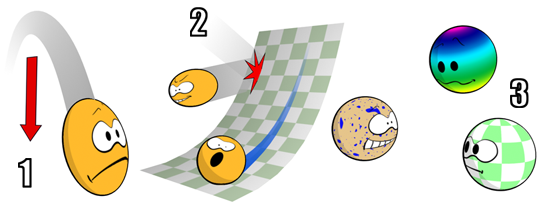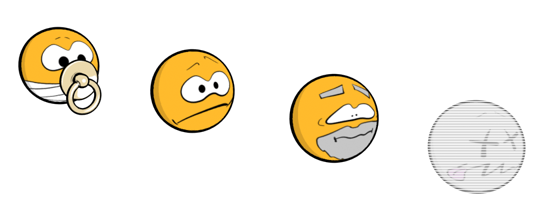Another way of looking at Particle Flow is from the perspective of an individual particle. Each particle first comes into existence, or is born, via the Birth operator, which lets you specify when to start and stop creating particles, and how many to create.
The particles first appear at an object called an emitter. By default, the emitter is the Particle Flow source icon using the Position Icon operator, but you can alternatively use the Position Object operator to specify that particles should be born on the surface of or within any mesh object in the scene.
After being born, particles can remain stationary at the emission point, or start moving in two different ways. First, they can move, physically, within the scene at a speed and in a direction specified by various actions. These are typically Speed operators, but other actions can also affect particle motion, including Spin and Find Target. In addition, you can use the Force operator to affect their motion with outside forces.

1. Particle immediately after creation, with no speed.
2. The Speed operator sets the particle in motion.
3. The particle continues moving until acted upon by another action.
The second way that particles move is logically, from event to event through the particle diagram, as constructed in Particle View. Each event can contain any number of operators that can affect, in addition to motion, a particle's surface appearance, its shape and size, and others.
The particles start out in the birth event, which typically is the first event after the global event. During a particle's residence in an event, Particle Flow evaluates each of the event's actions from top to bottom, once per integration step, and makes any applicable changes to the particle. If the event contains a test, Particle Flow determines whether the particle tests True for the test's parameters, such as whether it has collided with an object in the scene. If it does, and if the test is wired to another event, Particle Flow sends the particle to the next event. If it doesn't, the particle remains in the current event, and may be further acted upon by its operators and tests. Thus, each particle exists in only one event at a time.

An action in an event can change the particle shape (1), or the particle spin (2), or spawn new particles (3).

Actions can also apply forces to particles (1), specify collision effects (2), and alter surface properties (3).
In this way, the particle continues to travel through the system. Due to the flexible nature of schematic construction in Particle Flow, a particle may be redirected to the same event several times. But at some point, you might want the particle's life to end. For this purpose, you'd use the Delete operator or the Collision Spawn test or Spawn test. Otherwise, the particle lives throughout the entire animation.

Particle age can be used to kill a particle.
As a particle moves through the system, it's accompanied by a number of channels. For example, each particle has a speed channel that defines how fast it moves, and a material ID channel that lets Particle Flow know which sub-material to apply to it. However, the material itself is not defined by a channel, but by a Material operator that acts locally or globally. Properties that are defined by channels persist, unless altered by an action. For example, the Material Dynamic operator can change a particle's material ID. In effect, by setting up a particle diagram and modifying how particles look and act during the animation, you’re deciding how channel values change based on events and animation keyframes.